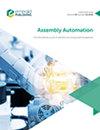模块化自动装配系统设计阶段设计复杂性评估方法
IF 1.7
4区 计算机科学
Q3 AUTOMATION & CONTROL SYSTEMS
引用次数: 0
摘要
目的:为了找到能够生产所有产品变体的最小投资和最佳质量性能的系统,在早期概念阶段评估设计装配系统的复杂性是必不可少的一步,它有助于并指导设计师以最小的复杂性创建面向产品和系统的装配解决方案。本文的目的是提出模块化自动化装配系统设计中复杂性的量化测量方法。设计/方法/方法可配置装配系统正在成为一种趋势,它使公司能够快速响应由不同产品变体引起的变化,而无需大量投资。其中一个促成因素是装配模块的模块化解决方案的可用性,可以根据不同的技术需求进行配置。本文提出了一种基于模糊评价的模块化自动装配系统设计阶段设计复杂度计算方法。模糊语言变量用来衡量影响因素之间的相互作用,以处理判断的不确定性。该方法通过三种矩阵来描述基于功能的装配模块、设计复杂性因素、零件属性和产品组件作为主要影响因素对模块化装配系统构建的影响。设计复杂性是基于这些评估得出和量化的。研究结果提出了一种形式化的量化方法,可以从一开始就评估模块化装配系统的设计复杂性,这可以被识别并用作提前指示性能质量和投资成本的标准。建立了基于模糊逻辑的数学模型,为本文的研究提供了理论和实践指导。为了验证预测模型的有效性,基于回归分析估计了评估的系统设计复杂性、实际装配不良率和投资成本之间的统计关系。所提出的方法的应用是证明了关于一个传统的后驱动单元在汽车工业。原创性/价值本文提出了一种成熟的方法,解决了模块化装配系统设计中复杂性的度量问题。它将有助于以定量方法更好地分配资源和估算成本来运行设计过程。本文章由计算机程序翻译,如有差异,请以英文原文为准。
A method to assess design complexity of modular automatic assembly system in design phase
Purpose
To find the system with minimum investment and best quality performance that is capable of producing all of the product variants, assessing the complexity of designing assembly system at the early concept stage is an essential step, which helps and instructs a designer to create a product- and system-oriented assembly solution with the least complexity. The purpose of this paper is to propose a quantifying measurement of complexity in the design of a modular automated assembly system.
Design/methodology/approach
The configurable assembly system is becoming a trend, which enables companies to quickly respond to changes caused by different product variants but without a large investment. One of the enabling factors is the availability of modular solutions of assembly modules that can be configured according to different technical requirements. This paper develops a methodology using fuzzy evaluation to calculate the design complexity in the design phase for a modular automatic assembly system. Fuzzy linguistic variables are used to measure the interaction among the influence factors, to deal with the uncertainty of the judgement. The proposed method investigates three matrices to present how the function-based assembly modules, design complexity factors, part attributes and product components, which are regarded as the main influence factors, complicate the construction of a modular assembly system. The design complexity is derived and quantified based on these assessments.
Findings
The proposed approach presents a formal quantification to evaluate the design complexity with regard to a modular assembly system from beginning, which can be identified and used as criteria to indicate the quality of performance and investment cost in advance. A mathematical model based on the fuzzy logic is established to provide both theoretical and practical guidance for the paper. To validate the predictive model, the statistic relationships between the assessed system design complexity, real assembly defect rate and investment cost are estimated based on regression analysis. The application of the presented methodology is demonstrated with regard to a traditional rear drive unit in the automotive industry.
Originality/value
This paper presents a developed method, which addresses the measures of complexity found in the design of a modular assembly system. It would help to run the design process with better resource allocation and cost estimation in a quantitative approach.
求助全文
通过发布文献求助,成功后即可免费获取论文全文。
去求助
来源期刊

Assembly Automation
工程技术-工程:制造
CiteScore
4.30
自引率
14.30%
发文量
51
审稿时长
3.3 months
期刊介绍:
Assembly Automation publishes peer reviewed research articles, technology reviews and specially commissioned case studies. Each issue includes high quality content covering all aspects of assembly technology and automation, and reflecting the most interesting and strategically important research and development activities from around the world. Because of this, readers can stay at the very forefront of industry developments.
All research articles undergo rigorous double-blind peer review, and the journal’s policy of not publishing work that has only been tested in simulation means that only the very best and most practical research articles are included. This ensures that the material that is published has real relevance and value for commercial manufacturing and research organizations.
 求助内容:
求助内容: 应助结果提醒方式:
应助结果提醒方式:


